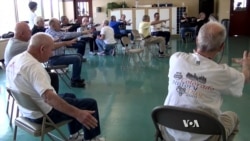Exercise could be the new prescription for Parkinson's Disease, a progressive disorder of the nervous system that affects movement. More than six million people worldwide suffer from Parkinsons and they're traditionally treated with medication and surgery. But 75-year-old Gary Sobel, who was diagnosed with the disease in his early sixties, took a different approach; rather than following his doctors' recommendation to take it easy, he turned to exercise. It changed his life, and now, he's changing others'.
Hitting bottom
Parkinson's is marked by tremors, muscular rigidity, and slowed movement, symptoms which worsen over time. Four years ago, Sobel’s Parkinson’s became so severe, he couldn’t get out of bed without help.
“Walking was a problem because I would trip and fall," he recalled. " Getting in and out of a car - I couldn’t drive anymore because my reflexes were too slow. I didn’t trust myself if I had to make a sudden stop, you’re just too slow in your movements.”
Sobel had been an athlete In his early 60s, running in marathons. After his Parkinson’s diagnosis in 2008, when doctors advised him to avoid exercise to prevent accidents, he gave up on working out. Also fearful of side effects from Parkinson’s drugs, he avoided medications. Then one day, his hands were shaking so much, he could not sign his name to pay a bill.
"I hit bottom that day, and I said, this is absolutely ridiculous, that I can’t even write a check.”
To reduce tremors enough so that he could at least try exercise, Sobel started low doses of Parkinson’s medicine. To strengthen his hands, he started squeezing water from wet towels. And it worked. After six weeks, he regained enough control to write again.
Based on that success, Sobel moved on to lunges that strengthened his legs. He took exercise classes and trained as an instructor. Today, he can hike, and work out, and he leads classes in his home town of Boulder, Colorado, for other Parkinson's patients, spreading his message about the benefits of working up a sweat.
Doctors take note
Success stories like these have gained notice in the medical community, according to University of Colorado physician, Heather Ene, a neurologist who specializes in movement disorders.
She says there has been a complete shift towards exercise as a mainstay in treating Parkinson's Disease. And, she observes, new research is leading to recommendations for exercise that’s even higher intensity, greater duration, and more often.
“It’s not necessarily going to slow the disease progression such that people don’t need medications," she stressed. "In fact, it's very unlikely that it's going to create that much difference. But it can be very helpful in slowing the transition to disability. That’s part of what we’re trying to do.”
In addition to the physical benefits, Ene says Sobel’s exercise classes offer an emotional lift - the community support that comes from being in a class among others with Parkinson’s, taught by a man with Parkinson’s.
“His enthusiasm is infectious, and I think that people really pick up on that and they spread it.“
A reason to exercise
In the three years that Sobel has been teaching those classes, he’s helped thousands of people with Parkinson’s. He says he pushes each person to do more than they think they can, because the rewards are sweet.
“I want them tired," he explained. "At the end of the day, I ask them if they're tired, and if they say 'yes,' I'm happy."
His students are happy, too. Some of them attend his exercise classes several times a week. One man gave three reasons for coming to work out: "One, I have Parkinson’s disease, two, I need the exercise, and three, I’m here for the camaraderie.” Another student said, “I like to come because I feel better while I’m here and after I leave.”
Sobel says all this has also helped him.
“This is a degenerative disease that can get nasty. I’m winning the battle right now, and I don’t know how long I can continue winning the battle, but I’ll do what I can.”
As part of doing what he can, Sobel has trained over 100 instructors throughout the United States in his methods of leading Parkinson’s exercise classes. He’s also helped start other classes in his area for people with Parkinson’s, including yoga, Tai Chi, dancing and circuit training.








